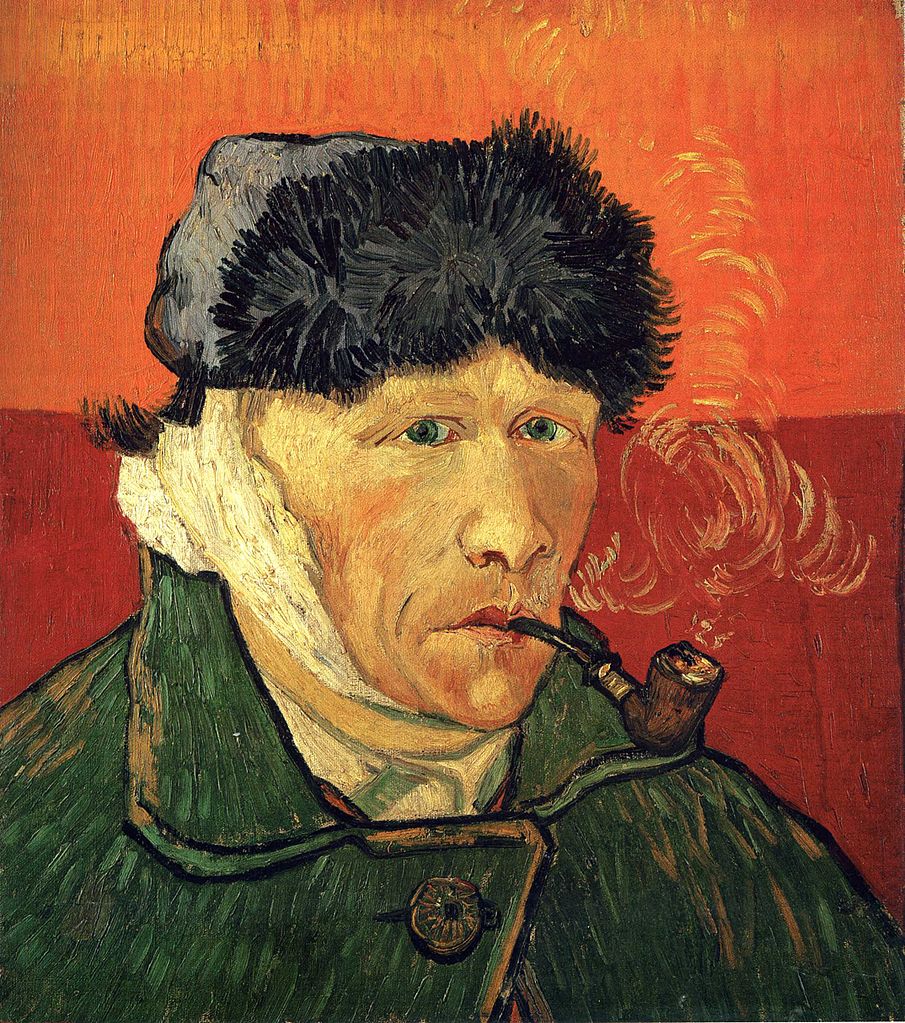Vincent Van Gogh was an admired artist, who was also a troubled and “tortured genius.” His artwork, Starry Night, Bedroom in Arles, and many others have earned him fame and recognition as one of the greatest artists of his time. But what many remember most about this artist is the story of his severed ear. Although his art is exemplary, his struggle with mental health and self-harm is admirable. His struggle was overlooked due to his incredible talent. He was successful as an art dealer, but as an artist, he had to prove himself with the headquarters of international art dealers, Gopil & Cie. During his lifetime, Van Gogh was the poster boy for the image of starving artist. His artwork was not recognized until much later in his career, which could have been a leading cause of his major depression and anxiety.1
Van Gogh, born in the Netherlands, decided to start his career in Paris in the 1880s, where many of the age’s great artists also resided. He believed he could get recognition for his pieces through his younger brother, Theo, who made his living as an art dealer. His brother introduced him to many artists, including Georges Seaurat, Camille Pisatto, and Paul Gauguin. Upon meeting these successful artists, Van Gogh was greatly inspired by their work and began creating his own artistic style, beginning in 1883. Later the same year, Van Gogh rented a small house in Arles, in the south of France. Paul Gauguin and Van Gogh became close friends and later roommates. They consistently bounced ideas off of each other and created a strong friendship.2

Like many friendships, theirs was rocky, and they found themselves drifting apart. Gauguin had moved on to a different artistic style and was exploring other ideas. Van Gogh at the time, had been reciprocating signs of depression and mental health issues, but at the time, these symptoms were considered normal. When Gauguin decided to explore other art spectrums, it involved moving out of the house he and Van Gogh shared. He broke the news to his roommate about his intentions, and this evidently this made Van Gogh go over the edge. He did not take the news lightly and both men began verbally arguing. Van Gogh had disappeared for a few hours and when he returned to confront Gauguin, he had a razor blade in hand threatening to hurt Gauguin.3
During the confrontation, however, Van Gogh was hesitant to hurt his friend and decided to turn the blade on himself and completely cut off his ear. Gauguin left him bleeding and alone. Van Gogh bandaged his head and began drowning himself in alcohol. During this episode, he walked out of his home and into the streets where he found a prostitute. The ear that he had severed off of himself had been neatly wrapped in a cloth; since Van Gogh was still heavily intoxicated, he decided to present this token to the prostitute. Patiently, she ran off and alerted the police about her encounter and they immediately rushed to his home.4
Shortly before Christmas Eve, Van Gogh was found by police in his bed, partially conscious and with major blood loss. Authorities rushed him to the hospital where he surprisingly recovered. Meanwhile, Gauguin was brought into questioning, but gave no testimony on the incident. It was believed that Van Gogh had suffered a severe mental breakdown long before he had severed his ear, but that this created a ripple effect that led to lunacy. The real reason behind the infamous Van Gogh ear-cutting may never be known; Gauguin had promised Van Gogh a pact of silence on the situation in letters that they supposedly exchanged. 5

After the incident, Van Gogh was admitted into a psychiatric facility in hopes of recovering mentally and physically. The dramatic change was not helpful for such a troubled artist, and in July of 1890, Vincent Van Gogh ended his life with a revolver. Before his suicide, however, he created a very iconic painting, Self Portrait with Bandaged Ear 1889. Van Gogh intended to persuade his doctors that he was perfectly able to continue working and creating art by creating this self portrait. He presented his piece, leaving a trail of wonder for his supporters as to why he included certain details in this particular piece, mainly because he continued to paint himself in the same yellow house he and Gauguin shared. Doctors overlooked these details and allowed Van Gogh to leave the facility.6
The epidemy of many artists like Van Gogh is often associated with mental instability, drug use, and alcohol abuse. Van Gogh had an array of medical issues that were tied back to his coping mechanisms (alcohol abuse), and as a result, many did not understand the struggles he faced and degraded him as a person while idolizing his artistic talent. As said before, the real reason behind his mutilated ear will be unclear, but his work and talent will continue to inspire and educate.
- Adam Gopnik, “Van Gogh’s Ear,” The New Yorker, Literature Resource Center (January 4, 2010): 48. ↵
- “Who Really Cut Off Van Gogh’s Ear?” Weekend All Things Considered, Literature Resource Center, (May 2010). ↵
- “Who Really Cut Off Van Gogh’s Ear?” Weekend All Things Considered, Literature Resource Center, (May 2010). ↵
- Belinda Thomson, “Comparing lives: issues of balance in biographical writing,” Literature Resource Center, French Politics, Culture and Society 24, no. 2 (2006): 60. ↵
- Tim Suermondt, “All the Answers.” Literature Resource Ceter, Prairie Schooner 85, no.3 (2011): 47. ↵
- Tim Suermondt, “All the Answers,” Literature Resource Center, Prairie Schooner 85, no. 3 (2011): 47. ↵



170 comments
Andrea Degollado
As someone who really enjoys art, and in fact loves Van Gough, I found this article was very interesting and entertaining to read. Ofcourse I knew that Van Gough had one ear, as that is one of the qualities that stands out and is why most people know of Van Gough. However what I did not know was that what drove him over the age was his roommate moving out. It was also sad to read that his friend just left him there bleeding out. Ive read of several bright artist suffering from severe depression or mental issues which is shocking to me.
Destiny Lucero
I believe there is a correlation between mental health and the creative mind, so I think this article is spot on. It makes sense that in his journey as a struggling artist he grew depressed with anxiety, only to get worse with a broken friendship. He must have done something truly horrible to have Gauguin not seek help and leave him alone. If Van Gogh properly knew how to cope, and Gauguin searched for help sooner in their relationship, and his talents didn’t overshadow his issues, he may not have taken his own life.
Shriji Lalji
Although I was aware of the beautiful art Van Gough had created, I was not very knowledgable about his life. This article was really informative for me. There should be a study of the minds of creative musicians and artists because there seems to be a pattern of depression and substance abuse amongst the most talented creatives. I am not very educated on the lives of many creatives however most of them seem to face very excruciating life experiences which they express through their craft. I wonder how all this correlates with their thinking, substance abuse, and incredible work.
Francisco Cruzado
I discovered Van Gogh due to a band called Van Gogh’s ear, and then made a research by myself on the topic. I remember his struggle with poverty, as many artists of the time did, and how by the end of his life, he turned himself ultra-dependent on his brother Theo, who tried to help him as much as he could. His staying in a house for lunatics always intrigued me, and I would honestly be really interested in reading more into that part of his life. It is interesting how many great characters of history are so erratic in their lives.
Francisco Cruzado
I personally discovered Van Gogh due to a band called Van Gogh’s ear, and then made a research by myself on the topic. I remember his struggle with poverty, as many artists of the time did, and how by the end of his life, he turned himself ultra-dependent on his brother Theo, who tried to help him as much as he could. His staying in a house for lunatics always intrigued me, and I would honestly be really interested in reading more into that part of his life. It is interesting how many great characters of history are so erratic in life.
Micheala Whitfield
Van Gogh is my favorite artist of all time. The reason why I enjoy his artwork is due to his illness. He painted what he saw in his mind and in his mind was a jumbled world. Van Gogh is a prime example of how talent and skill are more important to people than the health of individuals. People care about what is going to make money. It also opens the door on how people with mental problems visually see things different from others. They are on another level of imagination due to what they go through. He struggled for years with depression to the point he harmed himself. Yet, his intelligence and talent got him out of a hospital which he clearly should have stayed in. To this day people talk about his artwork and his creative skill yet, there is no mention of how mentally ill he was. It shows that even today, just like back then, his talent meant more than the fact he was ill. I loved this article.
Alexis Aranda
I think Van Gogh is such an interesting artist. I’ve always heard about him having only one ear, but I never looked into his mental illness. It makes me upset to know that he was a starving artist and that his mental illness was always thrown under the rug. I believe his art was beautiful and hope that his story serves as yet another reason why mental illness should be looked further into and investigated.
Cristianna Tovar
I always knew that Van Gogh had a severed ear, but until I read this article, I had no idea why. Although he was a very successful and highly-recognized artist, I found it sad that his mental illness and self-harm were overlooked. The fact that Van Gogh cut off his own ear after his friend told him that he would be moving out highlights Van Gogh’s struggles with controlling his emotions. Great article!
Margaret Maguire
Vincent Van Gough created some really beautiful pieces of art. I knew that Van Gough cut off his ear but I never knew why. He cut off his ear because he got frustrated with his former roommate for leaving without warning him and after Van Gough and his roommate argued he cut off his ear. I also learned that Vincent Van Gough was put into a mental hospital after this incident. This was a really interesting article and I wish it was longer.
Victoria Davis
I learned about Van Gough from my high school art class. I did know he only had one ear, but never really talked in depth about his mental illness and the problems it gave him. He was such an amazing artist with so much evident talent that he deserved treatment. This article really shows how everyone was mesmerized by his masterpieces and neglected the artists well being.